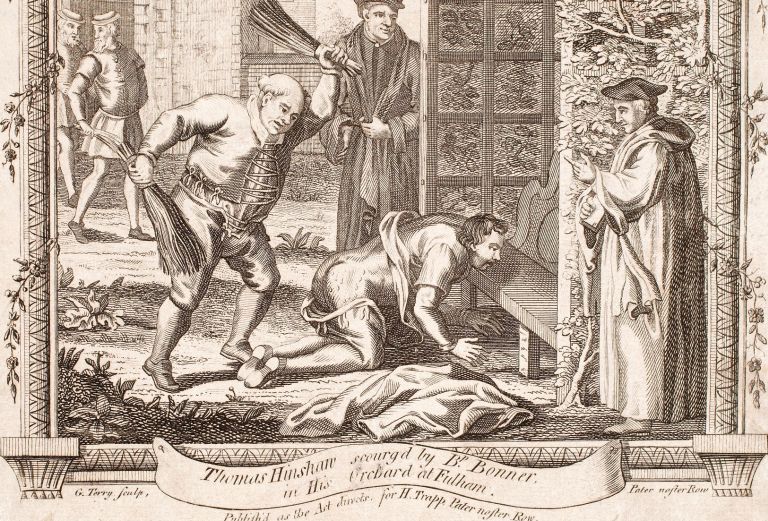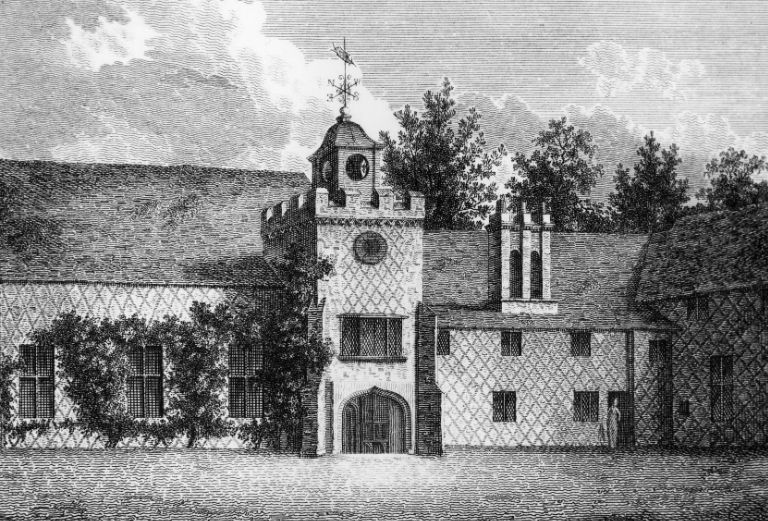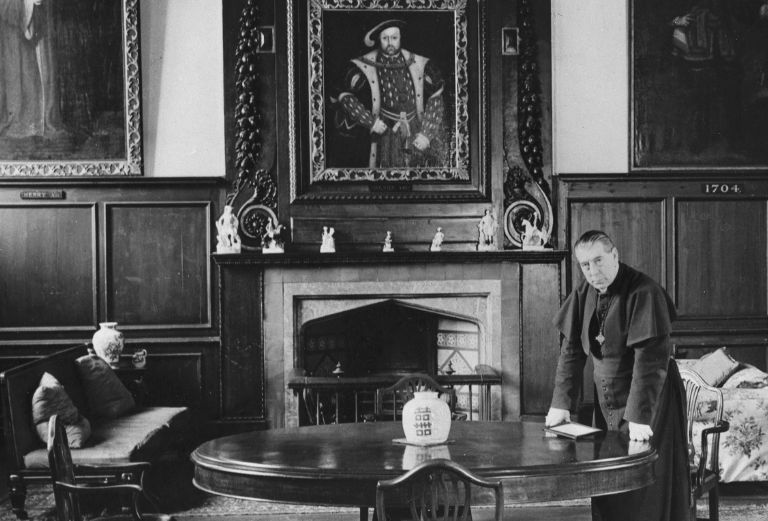
By Philip Carr, volunteer film-maker
The site of Fulham Palace in west London has been owned by the Church for over 1,300 years and home to Bishops of London over many centuries. Several of them came to a sticky end: in 1381 Bishop Sudbury was dragged to Tower Hill and beheaded; Bishop Ridley and his colleagues Bishop Latimer and Bishop Cranmer burnt at the stake in 1555; and Bishop Laud beheaded for treason in 1645. So given its turbulent and sometimes bloody history, it is no surprise that reports of ghosts and paranormal occurrences go back as far as the 1780s and continue to this day.
Bishop Bonner
In the 16th century, during the reign of Queen Mary I, the Catholic Bishop Edmund Bonner tortured and imprisoned Protestants at Fulham Palace, hence his unofficial title ‘Bloody’ Bonner. A devout but cruel man wielding great power, he was cardinal Thomas Wolsey’s chaplain which brought him to the notice of King Henry VIII and Thomas Cromwell.
In Foxe’s Book of Martyrs he is described:
“This cannibal in three years space three hundred martyrs slew
They were his food, he loved so blood, he spared none he knew”
Brutal examinations were carried out by Bonner on the heretics in the great hall and the Medieval chapel.
Below stairs near an old kitchen and servant’s hall stood a coal cellar which was used a dungeon. It was said that there was a tunnel from this cellar, lined with rotting skeletons, linking the Palace to Fulham Palace Road where Bonner’s mother lived, now the Golden Lion, the oldest pub in Fulham.
Over in Bethnal Green, where he also had a mansion, a ghostly coach and horses was allegedly seen. Bonner Road, Bonner Street and Bonner Bridge are named after him, as well as a local pub, the Edmund Bonner which also reported ghostly activity.
Before he came to London in the 1530s, Bonner was rector at St Nicholas Church in Dereham, Norfolk where there is a cottage museum named after him. There were reports in Dereham that his ghost has been seen riding in a “black carriage drawn by horses so dark that they become almost invisible at night.” (Is this the same coach seen in Bethnal Green perhaps?)
When Queen Elizabeth I came to the throne Bonner was banished to Marshalsea prison where he died. As he was so detested he was buried secretly at midnight in an unmarked grave at St George’s Church in Southwark. His body was later moved to Copford (an ancient manor of the Bishop of London) near Colchester, and buried in the church there. It was rediscovered in 1810 when a grave was being dug for a recently deceased rector.
Tales of the ghost of Bonner at Fulham Palace have existed for over 200 years. His spirit is reputed to walk in the north rooms of the Tudor courtyard. The latest sighting happened there in early 2019. Senior site manager Steve Bevan, who as overseeing the major Palace renovation, was the first one on the site in the north rooms one early Saturday morning: “The rooms were still dark but there was a light glowy thing coming towards me. I wanted to turn on the lights to see what it was but as soon as I switched it on, it disappeared, going through me. I could feel a cold wind. It was really strange. I was shivering after this incident – and I am not easily scared.”
Another thing that Steve and his colleagues had noticed was a fishy smell in the same room in which he met the ghost. It still comes up every now and then even though no one in the Palace is eating or cooking fish and is now the entrance to the new museum.
See the interview I filmed with Steve Bevan:
Visitors often talk of a figure, said to be Bonner, in the great hall. An apparition was witnessed there in 1989 by a former caretaker, Mr Newman. He saw a Bishop in old clerical dress come in and walk across the hall. Halfway across the Bishop stopped, bent over and adjusted his wrinkled stockings. He then continued to walk through the wall. On checking old plans Mr Newman discovered there used to be a door there. (This door has now been restored in the current works.)
In the book Bishop Bonner’s ghost (1789) by Hannah More another encounter with Bonner is described:
In the gardens of the palace at Fulham is a dark recess; at the end of this stands a chair which once belonged to Bishop Bonner. A certain bishop [Bishop Porteus] of London, more than 200 years after the death of the aforesaid Bonner, just as the clock of the gothic chapel had struck six, undertook to cut with his own hand a narrow walk thro’ this thicket, which is since called the monk’s walk. He had no sooner begun to clear the way than, lo! suddenly up-started from the chair the ghost of Bishop Bonner.
Hannah More

It’s testament to the enduring power of Bonner that he seems to have produced ghostly manifestations wherever he lived and which continues even after 500 years.
Although Bishop Bonner is the reputed ghost of Fulham Palace there have been many strange and unexplained occurrences that might indicate that the site is haunted by more than one ghost. The following experiences have been compiled from stories passed on by staff, volunteers, tenants and visitors:
Tudor courtyard
- People have been seen to appear around the fountain and instantly disappear.
- One very misty morning the caretaker saw a Bishop standing on the opposite side of the courtyard. However, an office worker with him saw nothing.
- Late one night a security staff supervisor was expected at the Palace. When he did not arrive one of the security guards went to the front door to look for him. He saw a dark shape on the ground and on investigation it turned out to be the supervisor. Apparently, on arrival at the courtyard he had seen a black ghostly figure and fainted.
Tudor courtyard south wing
- A cleaner working in one of the upstairs rooms saw a Bishop come in and walk through to another room. When she returned to the main part of the Palace she said that she did not realise there was a Bishop visiting. But her colleagues said there were no visitors in the Palace that day.
Tudor courtyard north wing
- A tenant working in a ground floor office late one evening heard a door open above him. He heard footsteps walk across the room and a door open and close on the other side. He thought that maybe another member of staff was in and went up to investigate but he found no one there. He went back downstairs to his office and continued working. He then heard the door reopen, the footsteps return across the room, and the other door open and close.

Corridor to the chapel
- A volunteer guide walking along the corridor towards the chapel heard footsteps above. The volunteer was wearing soft soled shoes and each step she took was matched by the footsteps above. She stopped at the bend of the corridor but the footsteps carried on.
Great hall
- One evening when locking the large wooden door a member of staff felt the door push back on him. Thinking there was someone trying to get in he opened the door but no one was there.
- A member of staff entered the locked hall from the north eastern fire exit. He smelt tobacco smoke. He went straight to the front door and unlocked it. There was no one smoking in the vicinity. Another member of staff confirmed no one had been smoking. When they returned to the great hall the smell had gone.
Double doors between the great hall and the corridor
- One evening when locking up two members of staff witnessed these doors open on their own. One of the staff actually commented that they appeared to be pulled open rather than just blown open. As the entire Palace was secure and all the internal doors shut the probability of a draught was highly unlikely.
Bishop Howley’s dining room
One member of staff and a few volunteers over many years have smelt tobacco smoke in the centre of the room. On one occasion a member of staff and a volunteer were the only ones on the premises when the smoke was smelt. They searched inside and out but no one could be seen.
Bishop Porteus’s library
- Bishop Porteus had a horror of being buried alive, so in accordance with his will his body was left for several days in the chapel to ensure that “return to life is naturally impossible”
- A member of staff was retelling the story of the sudden death of Bishop Lowth’s daughter Frances to a visitor. He walked around the desk to show the visitor the book in the display case, which described her death. In front of the shop counter they both walked through a cold spot and reacted simultaneously; each saying to the other ‘Did you feel that?’
Servants’ staircase outside Bishop Sherlock’s room
- Two visitors, who said they were psychic, claimed to feel very cold by the staircase. One claimed to have been pushed when she tried to stand on the stairs.
North east wing (Ecclesiastical Insurance Office)
- At the time that this wing was being prepared for the museum and offices there were no rechargeable power tools and workmen used tools connected by cable to the electricity supply. Several workmen experienced electric switches being turned off whilst using their electric tools.
Upstairs
- When the museum opened in 1992 there were three cats; one in the Gothic Lodge, one in the garden (the outdoor cat) and one in the Palace (the indoor cat). The indoor cat would follow staff around the corridors but appeared to be scared to go upstairs with them, always choosing to wait at the foot of the stairs for their return.
- During the Phase 1 restoration work in 2006 a room was used as a secure store for equipment. On more than one occasion, when the room was opened in the morning, things had been moved around.

Grounds
- Late one night in 1992, when the grounds were locked to the public, a security guard saw a young lady in a long flowing dress flitting between the trees. As he approached her he shouted ‘Hey what are you doing here’ she replied ‘I live here’ and promptly disappeared before his eyes. He returned to the Palace and locked himself in for the rest of the night. (Was this perhaps Frances, beloved daughter of Bishop Lowth who died in the middle of serving coffee to the Bishop of Bristol? Lowth wrote a Latin epitaph, Cara, Vale “Dear one, farewell!” on her sudden death, later set to music by the English composer John Wall Callcott)
- Early one morning a visitor walking near to the walled garden reported seeing a group of Victorian people walking along the path adjacent to the allotments. He added that one was pushing a bicycle.
Many thanks to Peter Trott, retired Fulham Palace museum steward for providing many of the above reports.